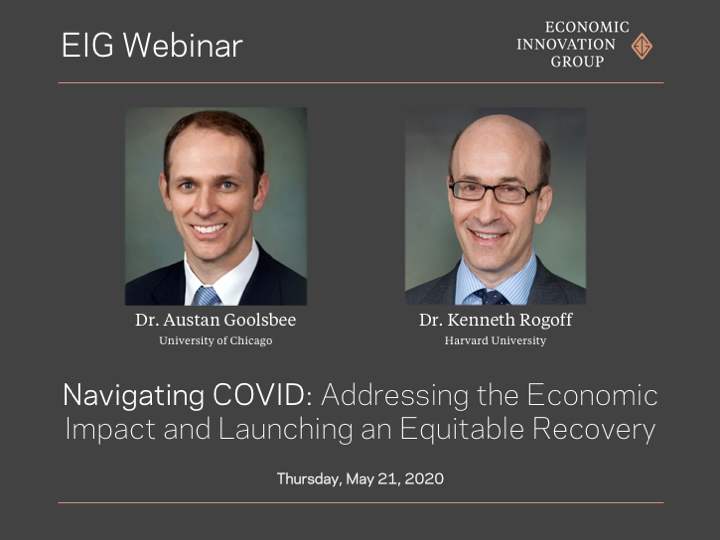On May 21st, the Economic Innovation Group (EIG) moderated a discussion with EIG Economic Advisory Board members Austan Goolsbee and Kenneth Rogoff on the current economic situation and how lessons from the Great Recession can mitigate the fallout from COVID-19 and set America on a path towards a strong and inclusive recovery.
Dr. Kenneth Rogoff is a Professor of Economics and the Thomas D. Cabot Professor of Public Policy at Harvard University. A leading scholar of financial crises, Rogoff is formerly Chief Economist of the International Monetary Fund and author of This Time Is Different: Eight Centuries of Financial Folly.
Dr. Austan Goolsbee is the Robert P. Gwinn Professor of Economics at the University of Chicago Booth School of Business. He served as Chairman of the Council of Economic Advisers and a member of President Obama’s cabinet from 2010 to 2011.
A recording of the webinar can be found here.
Key Takeaways
Novel characteristics of the COVID-19 crisis
- The economic figures are extreme. The worst year of the Depression saw unemployment grow 8%. However, we have now witnessed unemployment grow to 10% over the course of one month.
- The cause of the crisis was not economic and lockdown is not completely, legally driven. Hence, the economy could recover more quickly but many uncertainties surrounding recovery remain.
- Economic lockdown does not need to be seen as a trade-off between lives and jobs. The countries saving the most jobs are those that prioritized saving lives.
- What’s killing the economy is fear of infection. Therefore, the timeline for true reopening will depend on public sentiment and our ability to control the virus.
Comparisons with past economic crises
- Unlike the Great Recession during which many emerging markets were not severely hit, this crisis is truly global.
- The unique aspects of this crisis are the supply shock to global production, social distancing’s impact on trade and travel, and the pace of vaccine technology.
- In comparison to Spanish Flu, the global economy may be in a far better position to weather COVID-19. Then, few countries had the resources to deal with the flu in light of the end of WWI, which ultimately resulted in a massive loss of life due to the disease.
The response thus far
- The stimulus has not been “conventional.” The aim has been to keep the economy going until we could reopen. Much of the existing policy response is premised on the idea that the effects of COVID-19 will be short-lived, though it is not yet clear that this will be the case.
- A lesson of the Great Recession is the importance of maintaining public support for crisis response. A lack of trust could undermine further rounds of aid.
- Tension exists between long-term and short-term stimulus goals. There is a tradeoff between getting aid funding flowing and ensuring that money is always directed towards the right place.
Areas of focus for the rest of the response
- The crucial thing we can do for the economy is slow the spread of the virus. This would be much more impactful than relief packages. More testing, PPE, and medical personnel could make this happen.
- The Paycheck Protection Program (PPP) provides employers with a grant if they are able to restore their full-time employees by the end of June. With this impending deadline and without more direct relief, we may see mass bankruptcies leading to more unemployment.
- States will be running huge deficits. To cope with balanced budget requirements, these states will have to layoff employees or raise taxes which could have negative economic effects.
- Additional deficit spending will likely be necessary to make good policy possible. The purpose of debt is to spread risk over a long period of time and, in this case, the extreme cost of the public health crisis should be spread over a longer period.
Economic recovery
- The crisis will exacerbate existing inequality. Within the U.S., recovery from the Great Recession was very unequal geographically and COVID-19 will likely deepen those divides. Tax cuts may not be helpful as greater redistribution of income may be needed.
- This crisis may give us the potential to change and evaluate the social safety net, particularly in regard to healthcare.
- Immigration has a key role to play. The U.S. native-born population growth rate is the lowest it has ever been. If there is a sustained reduction in immigration, all of the issues associated with an aging population get worse.






